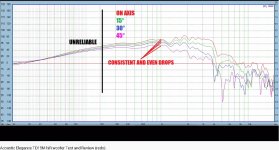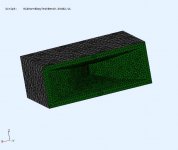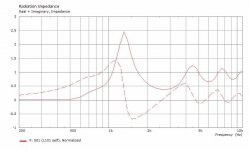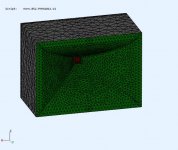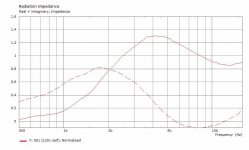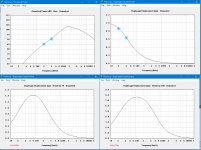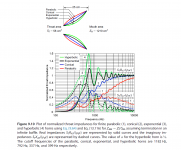hi, Mabat, what say you? We are only discussing, there is no argument (lol), I think these guys want me to entertain something a long the lines of models I see on your waveguide thread?
The crossover is actually 400hz (not 200hz like was 3 years ago)...Actually before DonK finished the roll over for the HVDiff I changed the XO point but by then Docali was too busy to help further...
The top Models I have from Docali are
drba_rad_isoc_250_camplo.ply
170hz HVDiff
Can I just scale these down to 320hz in Fusion360? Is it so simple as just scaling?...Maybe I can get someone...if I scale the HVDiff it will shrink the roll over Don K made so that won't be so simple..in a nutshell I need to change the tuning on these horns...the profile is what is most important...you'd think it would be easy to change the tuning after the profile has been figured....
It would be great to have a waveguide to compare SQ, one that can allow the axi to cross at 400hz.
The crossover is actually 400hz (not 200hz like was 3 years ago)...Actually before DonK finished the roll over for the HVDiff I changed the XO point but by then Docali was too busy to help further...
The top Models I have from Docali are
drba_rad_isoc_250_camplo.ply
170hz HVDiff
Can I just scale these down to 320hz in Fusion360? Is it so simple as just scaling?...Maybe I can get someone...if I scale the HVDiff it will shrink the roll over Don K made so that won't be so simple..in a nutshell I need to change the tuning on these horns...the profile is what is most important...you'd think it would be easy to change the tuning after the profile has been figured....
It would be great to have a waveguide to compare SQ, one that can allow the axi to cross at 400hz.
Last edited:
Ha Ha, I only wish it was reciprocated more often, too many years spent talking someone off the ledge..This is extraordinarily mildly put. I admire your communication skills
Another thing I have learned over time is that often what is asked for is not what is really wanted. So when you give the person what they asked for they are not happy because only then do they realise what it is they actually wanted.
It is for this reason I would not design something for camplo and I think he should actually do it for himself.
One thing that is not always apparent in the discussions of narrow vs wide pattern designs is that if done properly the wide pattern can be more similar off axis and therefore any reflections that return to the listening position are more spectrally similar to the on axis sound. This is something Floyd Toole talks about out of the blind perception tests but the theory does not seem to have been proven. This is something I would like to try out for myself to see if it is real.
- this is an important thing you've said and a thought that I also came to conclusion to make sense, a long time ago....to compliment this idea, an even fuller picture can be described....as you increase the amount of this off axis reflections, you create many more instances of reflections, as well as increasing indirect energy to direct energy, ratio...The more indirect energy you create, no matter how linear it leaves on departure, will be changed, during the rebound...this makes it that much more critical to treat the room properly to deal with the increased energy there...Even with a wide dispersion system, if you decrease reflections you will have an increase in resolution...this is the effect of the direct to indirect energy relationship.One thing that is not always apparent in the discussions of narrow vs wide pattern designs is that if done properly the wide pattern can be more similar off axis and therefore any reflections that return to the listening position are more spectrally similar to the on axis sound.
Heres a question...with a poorly treated room...would a narrow dispersion system out perform a wide dispersion system?
- wow you really are gifted with your verbal approach lol! ty you for saying that. I personally do not feel that anything here has been done in vain due to process of how that works? The E-tractrix I have now looks very similar to HVDiff...Anything better than what I have now, in terms of dispersion is going to be luxury because I previously specified a minimal limitation on the size of my sweet spot....its exactly how I landed at 350hz tuning. basically I just used HornResp and generated smaller and smaller tractrix/jmlc horns until the HF sweet spot was as small as I'd allow...the horn I have now is wider dispersion that that yet....in the future it sounds like I'll be able to keep 400hz XO and have even better dispersion...via OSWG or what have you but lets not over look the fact that I already am satisfied and if it gets better so be it?! I apparently have a good candidate for a shoot out since I have a "beamer"...and I like it lol!Another thing I have learned over time is that often what is asked for is not what is really wanted. So when you give the person what they asked for they are not happy because only then do they realise what it is they actually wanted.
Last edited:
5460(2/19.05)
= 573.22834645669291338583.
Nearfield... listening... 1-2 meters?
Are there any high efficiency controlled directivity designs out there with a 15" and a crossover under 573hz? (Besides mine and the Strauss)
why does this seem wider than its supposed to be?
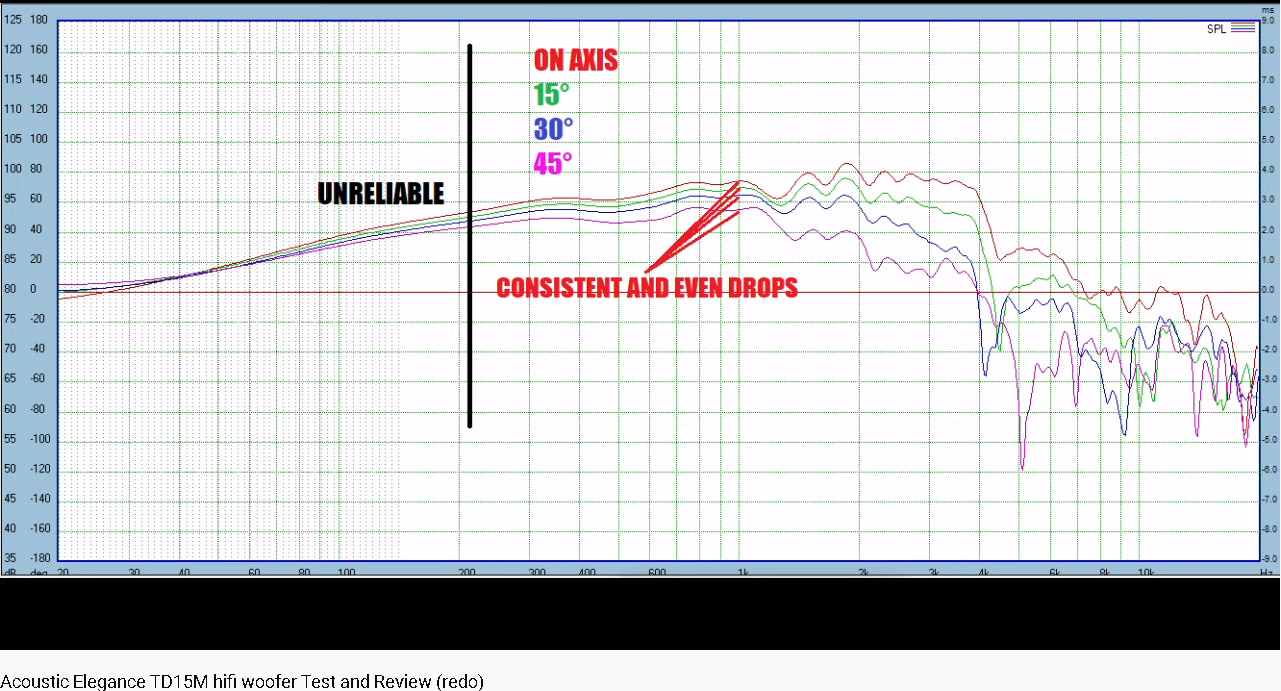
= 573.22834645669291338583.
significant directivity (ka = 2.0)
Nearfield... listening... 1-2 meters?
Are there any high efficiency controlled directivity designs out there with a 15" and a crossover under 573hz? (Besides mine and the Strauss)
why does this seem wider than its supposed to be?
Attachments
Last edited:
Perception is complex and there is a school of thought that says if the reflection is substantially similar but time delayed the ear/brain can recognise that and ignore it more easily.The more indirect energy you create, no matter how linear it leaves on departure, will be changed, during the rebound...this makes it that much more critical to treat the room properly to deal with the increased energy there...Even with a wide dispersion system, if you decrease reflections you will have an increase in resolution...this is the effect of the direct to indirect energy relationship.
I generally do not like much in the way of early reflections and I do find reducing them can seem to increase clarity which is perhaps what you are saying with resolution.
Depends if you like extra reflections or notHeres a question...with a poorly treated room...would a narrow dispersion system out perform a wide dispersion system?
If you like it that is great, I do think for the spectrally similar thing to work the directivity needs to be reasonably constant between flat and up to 3dB per decade.lets not over look the fact that I already am satisfied and if it gets better so be it?! I apparently have a good candidate for a shoot out since I have a "beamer"...and I like it lol!
One thing to remember and I think many people sometimes forget is that you are testing and listening very close and are in a strong direct sound field so things will be different there than out at 3+m.
JBL 4670D e. g. Crossed @500 Hz.Are there any high efficiency controlled directivity designs out there with a 15" and a crossover under 573hz? (Besides mine and the Strauss)
I had 2way 15"+2380a+950PB crossed @500 Hz ten yeas ago, Di was at least 3 at any frequency
It was a long time ago. I currently don't have 2" drivers to compare with current SEOS24\DCX464 etc. Corner placement, DBA subs and 3-5 meters listening distance now.Any comments on the 2380a?
I can't blame anyone but myself but how did I miss that this damn thing can play loud enough inside a house that it doesn't even need a damn horn to play 20,000-200hz even? 

 ( I think Gedlee hinted at it)
( I think Gedlee hinted at it)
I'm saying this after modelling some really hi tuned tractrix horns in Hornresp and looking at the SPL....I have no regrets...lol, it will be an interesting journey from here. Some where for this there is a line between fidelity and extension...the deeper its played, in particular without loading, the more excursion, so since it has enough XMAX to play to 200hz without a horn doesn't mean it should...How do I draw the line on excursion for modelling purposes?
I have to put a disclaimer on myself....from about may till november, I don't do much of anything but work, plus the times...sorry if I haven't made as much progress or seem to be playing catch up with stuff I might of learned already.
I am so mad at myself yet happy...so the Axi.....or even other large format compression drivers can be viewed as a 4" fullrange driver (or in my case 5-1/4?) with limited Xmax.....not only that but the uiltimate 4" fullrange driver in the terms of HF performance....in the domestic environment...which includes studio.
I'm saying this after modelling some really hi tuned tractrix horns in Hornresp and looking at the SPL....I have no regrets...lol, it will be an interesting journey from here. Some where for this there is a line between fidelity and extension...the deeper its played, in particular without loading, the more excursion, so since it has enough XMAX to play to 200hz without a horn doesn't mean it should...How do I draw the line on excursion for modelling purposes?
I have to put a disclaimer on myself....from about may till november, I don't do much of anything but work, plus the times...sorry if I haven't made as much progress or seem to be playing catch up with stuff I might of learned already.
I am so mad at myself yet happy...so the Axi.....or even other large format compression drivers can be viewed as a 4" fullrange driver (or in my case 5-1/4?) with limited Xmax.....not only that but the uiltimate 4" fullrange driver in the terms of HF performance....in the domestic environment...which includes studio.
Last edited:
Just to make sure I'm smoking what is being put down....Are we trying to say here that I can cross that Axi at 400hz with an OSWG without it loading to 400hz? I thought we had this conversation before and the verdict was a no? Am I mistaken?
Let's compare 2 horns that I have both physical items and simulation models. The SH402 (like a 2370a, diffraction horn) and a PHRN1014 (like the QSC, OS like) both are approx 90x50 coverage and relatively constant directivity. The complete model sim data is at Modular active 3 way - work in progress They are advertised to be useful to 400Hz and 500Hz respectively.
The actual SH402 requires 6dB EQ to make it flat at 800Hz, and the PHRN1014 requires 12dB and you can see that in the RadImp (loading) graph differences. So the answer depends on how much EQ you want to apply as you force output at lower frequencies. Both horn mouths are large enough to control the wavefront to approx 600Hz and used the same compression driver.
Attachments
Last edited:
ok I reaaally need to pay attention to my hornresp modelling cause I let the calculator change my exit size...ok
The smallest thing I can sim is a 1000hz horn...
but I can see that as long as my dimensions of the diaphragm are close, with this 1000hz tuning, theres no support at 200hzand400hz right?
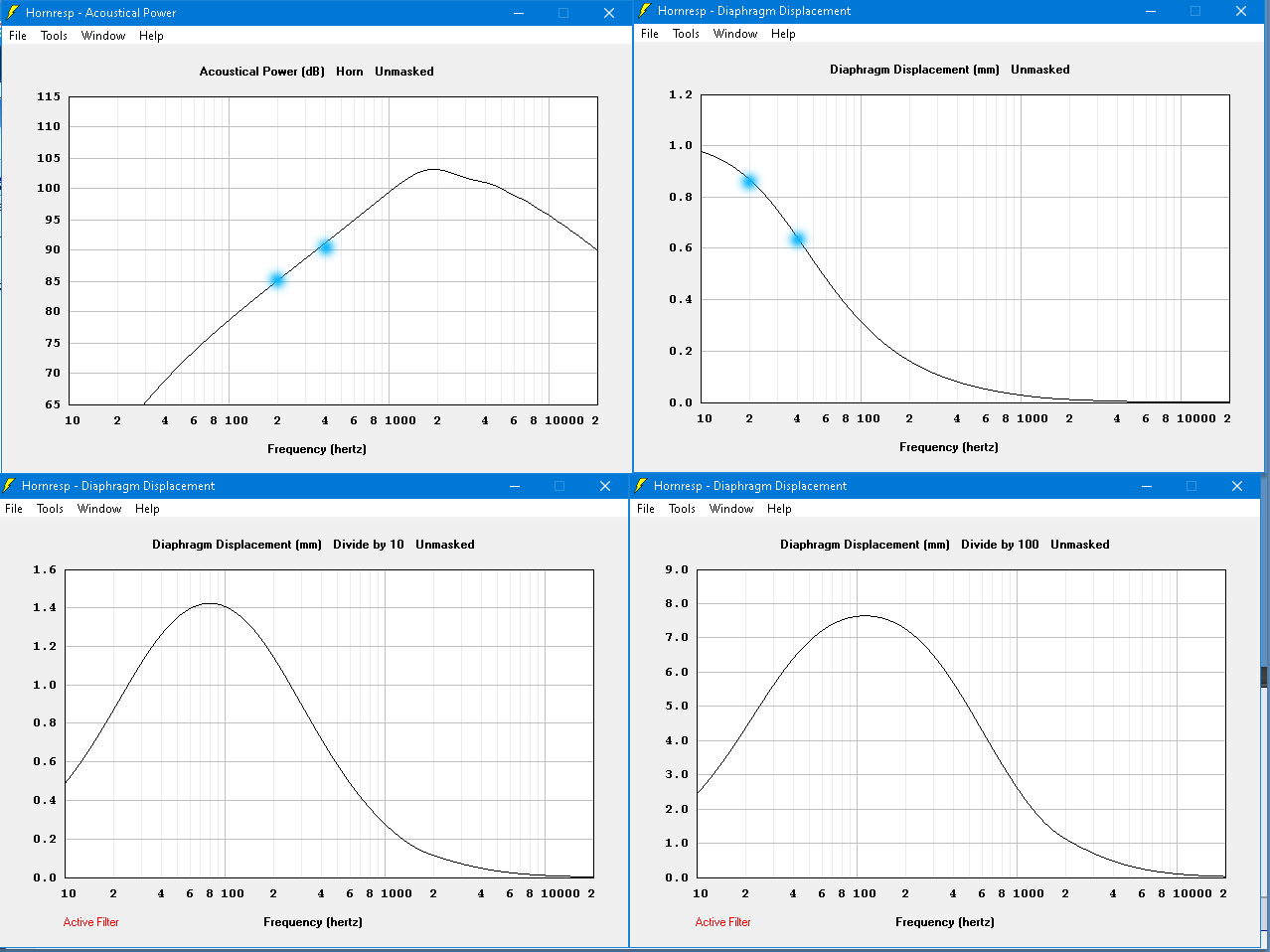
if thats too big let me know....on a 65" screen everything is small to me)
um the bottom left is after a 200hz 6db butterworth and the right is a 400hz.
The smallest thing I can sim is a 1000hz horn...
but I can see that as long as my dimensions of the diaphragm are close, with this 1000hz tuning, theres no support at 200hzand400hz right?
if thats too big let me know....on a 65" screen everything is small to me)
um the bottom left is after a 200hz 6db butterworth and the right is a 400hz.
Attachments
Last edited:
Let's compare 2 horns that I have both physical items and simulation models. The SH402 (like a 2370a, diffraction horn) and a PHRN1014 (like the QSC, OS like) both are approx 90x50 coverage and relatively constant directivity. The complete model sim data is at Modular active 3 way - work in progress They are advertised to be useful to 400Hz and 500Hz respectively.
The actual SH402 requires 6dB EQ to make it flat at 800Hz, and the PHRN1014 requires 12dB and you can see that in the RadImp (loading) graph differences. So the answer depends on how much EQ you want to apply as you force output at lower frequencies. Both horn mouths are large enough to control the wavefront to approx 600Hz and used the same compression driver.
Thank you for showing this Don. My first thought is that these two horns have resonates within the passband...with a waveguide the tuning is generally out of the passband (or at the tippy top of it, looking at Fluids waveguide) so the EQ is going to look different but your though set still applies, after all is said and done ...done how much eq...they are able to produce waveguides where the on axis response is nuetral...from the horn aspect, it starts at the Axi's free air measurement from here?
With the current 350hz horn only one low shelf is needed to tweak the slope...I'm not sure how much attenuation if any is needed, I figured out how loud white noise was before finishing that session and lost track on another rant...
Last edited:
Let's compare 2 horns that I have both physical items and simulation models...
...Both horn mouths are large enough to control the wavefront to approx 600Hz and used the same compression driver.
Thanks Don, good to see such comparisons.
Up-to-date overview of horn profiles with their respective impedances:
Attachments
Last edited:
Kippel? Is this what I need to investigate? How do I measure IMD and doppler and AMD...or better yet...why isn't this stuff already figured out? after a certain amount of excursion....no matter the size of the driver...certain distortions are eminent (probably amplitude modulation)....you guys must be keeping this information to yourselves or something?... I'd guess this be common knowledge amongst DIY designers. Who came up with the 2mm limitation for midrange drivers...whats the limitation for tweeters? I must be asking a crazy question and obviously something like 1mm and under is a good place to start huh lmao! I don't know! Guess this is my knew obsession for the moment. Maybe this is a unique question, whens the last time someone had a tweeter than could play to 400hz...pretty much anyone with a large format compression driver it sounds like but...I don't know what the heck is going on.
Last edited:
Let's compare 2 horns that I have both physical items and simulation models. The SH402 (like a 2370a, diffraction horn) and a PHRN1014 (like the QSC, OS like). They are advertised to be useful to 400Hz and 500Hz respectively.
The advertising obviously has nothing to do with practical reality
The values should be doubled, the 2370a can be used from about 800 Hz and the PHRN1014 from 1000 Hz.
Long ago it was determined that 2 mm is a critical threshold for Doppler distortion in woofers, I believe by a number of scientists at Philips.
Of course IMD is also excursion dependent (among other things).
For subwoofers, IMD and Doppler distortion are less relevant.
Excursion of compression driver diaphragms is often less than 1 mm, so IMD and Doppler distortion are rarely factors of significance.
Of course IMD is also excursion dependent (among other things).
For subwoofers, IMD and Doppler distortion are less relevant.
Excursion of compression driver diaphragms is often less than 1 mm, so IMD and Doppler distortion are rarely factors of significance.
Last edited:
One thing that is not always apparent in the discussions of narrow vs wide pattern designs is that if done properly the wide pattern can be more similar off axis and therefore any reflections that return to the listening position are more spectrally similar to the on axis sound. This is something Floyd Toole talks about out of the blind perception tests but the theory does not seem to have been proven. This is something I would like to try out for myself to see if it is real.
It has not been proven and Floyd and I agree that there is no definitive answer - it depends on listening source preferences.
As to tests, let me describe an unpublished one that we did.
Consider two sources, one wide and one narrow, both CD. With the wide one no matter how one points the system the reflection pattern remains basically the same. But, the narrow one can be pointed such that the farther wall gets more sound while the closer one gets less. Is this reflection pattern difference effective. We tried to test that.
In the test we (lidia, another DIY and myself) tried (I say tried because I don't think we were totally successful, as you will see,) to simulate this situation. We had >20 blind subjects where they were asked to point to the location of a virtual simulated source, with first reflections, and without. The accuracy of their guesses would show a degradation of imaging. Reflections clearly degraded the image stability when compared to no reflections. In the end the results were not "statistically significant" and so my wife did not want to publish a paper.
That said, the results did indicate that pointing a narrow directivity speaker at the far wall does improve image localization - it just wasn't "statistically significant" in this small and somewhat simple test.
Now, if localization is not what you are looking for since, perhaps the recording is done in-situ with lots of confounding reflections on the source added to those in the room, then adding spaciousness to cover those aberrations is going to be perceptually advantageous.
On the other hand consider a fairly dry studio recording where strong imaging is a goal. In this case the narrow directivity when properly setup can enhance the imaging - but of course spaciousness will degrade. But spaciousness is not a criteria in the most studio work.
This is precisely where Floyd and I agree to disagree since our musical tastes are on the two extremes and we understand what each is looking for and that they are different.
One will never find nirvana until they come to a decision about what is important to them - what they are willing to give up (spaciousness) or emphasize (imaging). Good speakers do both better, of course, but at the extremes of design - like what should the DI be - there isn't one answer. But both Floyd and I do agree that in either case smooth and nearly flat DI is essential. Exponential horns don't do that, they beam.
Kippel? Is this what I need to investigate? How do I measure IMD and doppler and AMD...or better yet...why isn't this stuff already figured out? after a certain amount of excursion....no matter the size of the driver...certain distortions are eminent (probably amplitude modulation)....you guys must be keeping this information to yourselves or something?... I'd guess this be common knowledge amongst DIY designers. Who came up with the 2mm limitation for midrange drivers...whats the limitation for tweeters? I must be asking a crazy question and obviously something like 1mm and under is a good place to start huh lmao! I don't know! Guess this is my knew obsession for the moment. Maybe this is a unique question, whens the last time someone had a tweeter than could play to 400hz...pretty much anyone with a large format compression driver it sounds like but...I don't know what the heck is going on.
It has, it just gets ignored. Doppler distortion in driver is not really an issue. It can be, of course, in a poor design, but it needn't be. And almost any nonlinear distortion in the driver itself needn't be an issue, so design it out. That's why you don't hear much about it because most professionals have moved on to topics of significance. Nonlinear distortion in drivers is not an issue. Again, Floyd Toole and I are complete agreement on this point - it's been laid to rest.
- Home
- Loudspeakers
- Multi-Way
- Is it possible to cover the whole spectrum, high SPL, low distortion with a 2-way?
